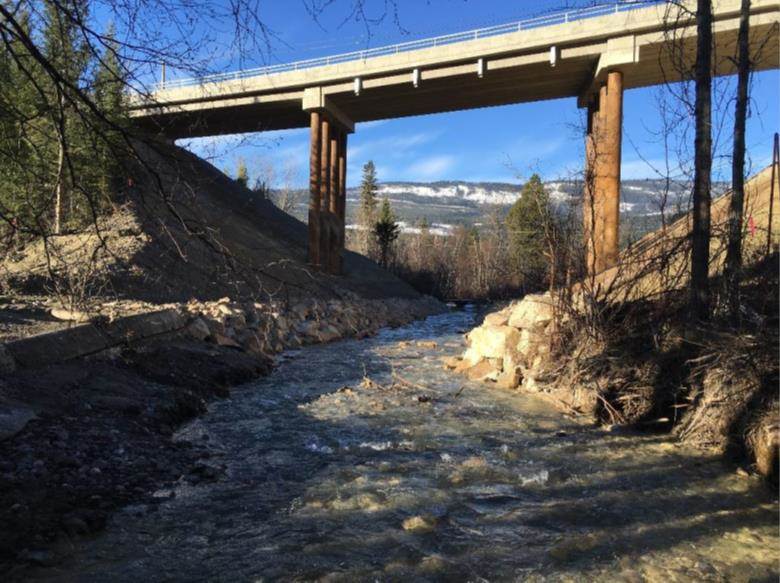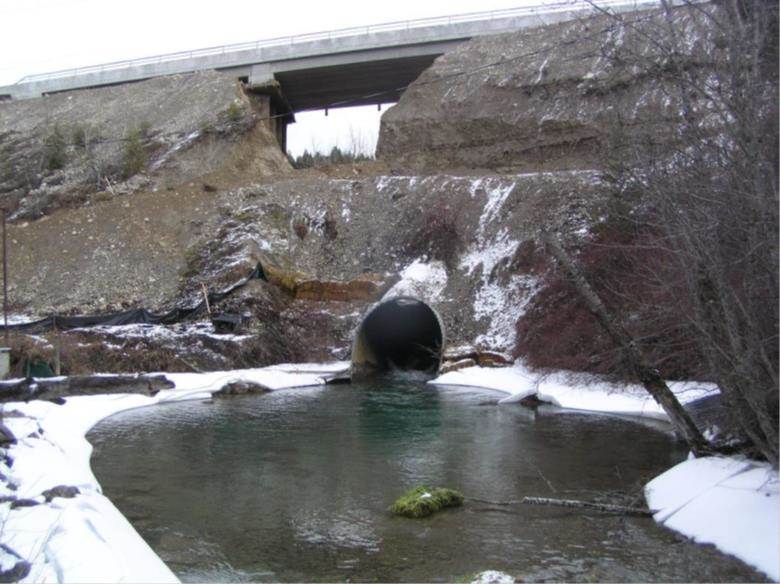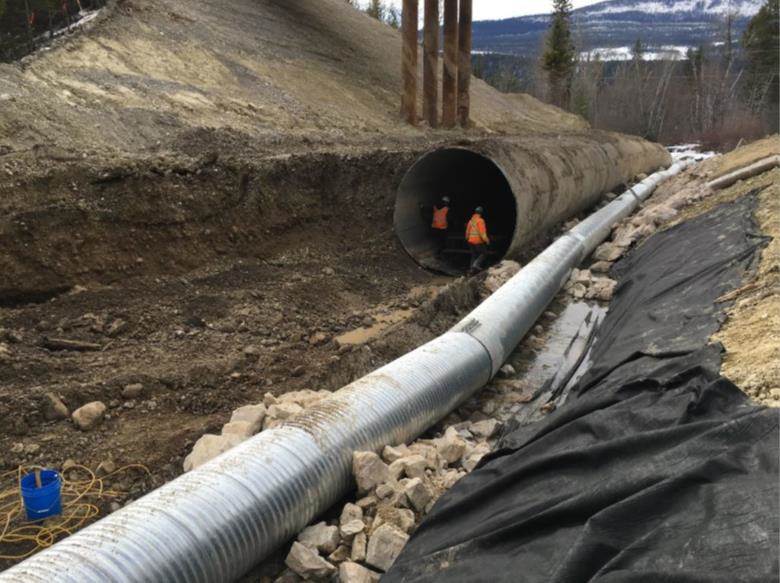
Sometimes we work on a project that changes not just the highway, but the world around it. Such was the case with our recent work on scenic Highway 95 at Luxor Creek. A key wildlife corridor connecting important animal habitats between the Purcell and Rocky Mountains is a step closer to reality thanks, in part, to the new Luxor Creek Bridge.
To say we are thrilled to be a part of making it happen is an understatement (normally, our work to repair or restore sections of BC highway is pretty straightforward – a road needs new pavement and we pave it, a bridge needs routine upkeep and we make sure it happens – you get the idea).
Out with the Old and in with the New
The old culvert at Luxor Creek, located about 20 km north of Radium, was a barrier for many decades, stopping fish from getting to spawning areas above the highway crossing because of its small opening and fast moving water. We normally aim to replace old culverts with modern, more fish friendly ones wherever we can but, in this case, a bridge was determined to be the best option.

To make the bridge a reality, we excavated tonnes of fill between the road and the old culvert, constructed the new two lane bridge and temporarily redirected Luxor Creek. Then we restored an 80 metre long section of the creek before setting the creek back to its original course. Phew! We are getting tired just writing about it.
Enhancements in the restored section of stream include:
- Installation of large woody debris,
- Construction of large boulder clusters and rock weirs,
- Creation of resting pools,
- Addition of spawning gravels
- Riparian planting
The new channel gives fish the freedom to move above and below the bridge all year round and, as the improvements mature, they will provide a variety of habitats for fish in all life stages to use.

Here’s Where Things get Bigger…
The new bridge is not only a huge environmental and engineering improvement where it stands; it links to a conservation initiative being undertaken by the Nature Conservancy of Canada right next to the project area. You see, Luxor Creek is an important tributary to the biologically rich Columbia River wetlands area which provides habitat for a large array of fish and animals. And, because of its closeness to Kootenay National Park, the Luxor Creek project enhances a key ecological movement corridor helping species such as: badgers, coyotes, mule deer, elk, moose, and black bears all of which are known to frequent the area. The project, dubbed the Purcell/Rockies Connectivity Initiative, is seeking to secure, restore, and enhance land and waters in the Rocky Mountain Trench area and the Luxor Creek Bridge is a key link in that chain.
Cool stuff, right? It goes to show that even the most routine work can have benefits far beyond the original project. If you are interested in learning more about the environmental work we do to improve the areas around our highways for human travellers and wildlife alike, we have more great “green” themed blogs for you to check out. See the project unfold in photos on our Flickr page. Have any questions about this or any other work we do? Let us know in the comments below.
TranBC Trivia
Our Environmental Enhancement Fund supports fish and wildlife passage improvements and restoration at stream and animal crossings on BC highways. This includes culvert retrofits and replacements to restore pacific salmon and trout access to underutilized habitat, and installation of wildlife tunnels.
You guys destroyed Luxor Creek. I used to Fish there and have fun with my Dad catching fish since I was 7 years old. I went to fish down in the area where the water poured out of the drain down stream. Then after you guys came, there is garbage and ledges up the stream under the over pass. There is also shallow water where there was once was deep slow water and lots of trout and fish.
Now ever since you guys came there are very little fish and the water is very shallow and slow with lots of rocks. I’m crying still today when I look at these photos remembering my fun times and now I am old enough to get my own fishing licence but what’s the point. please don’t do this kind of thing again.
Sincerely, Colton and Dave
Hi Colton,
We are sorry to hear this. We’ve sent your comment to the project manager for review and will let you know what we hear back.
Hi Colton and Dave,
When this project was completed, we restored the stream channel under the new bridge, as well as restoring fish passage where previously the fish could pass as they could not reach the outlet invert of the old culvert.
The project replaced a large culvert that was under approx. 20m of hwy fill. We built a bridge, dug out and removed the culvert, restored the stream back to its more natural state. The old culvert was a barrier to upstream fish migration under higher flow conditions and posed an ice jam/flood risk to the upstream RV park as well.
The new bridge is not only a huge environmental and engineering improvement where it stands; it links to a conservation initiative being undertaken by the Nature Conservancy of Canada immediately adjacent to the project area. Because of its closeness to Kootenay National Park, the Luxor Creek project enhances a key ecological movement corridor benefitting species such as: badgers, coyotes, mule deer, elk, moose, and black bears all of which are known to frequent the area. The project, dubbed the Purcell/Rockies Connectivity Initiative, is seeking to secure, restore, and enhance land and waters in the Rocky Mountain Trench area and the Luxor Creek Bridge is a key link in that chain.
Kokanee salmon runs in Luxor and other nearby tributaries are definitely cyclical, but we believe the big reason you see less of them at that location is that they are more widely distributed in the stream as a whole now that they can access more upstream habitat.